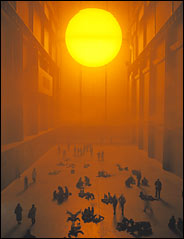| zondag 28 december 2008 |
 Scientists plan to ignite tiny man-made star Scientists plan to ignite tiny man-made starIt is science's star experiment: an attempt to create an artificial sun on earth - and provide an answer to the world's impending energy shortage. Housed within a hanger-sized room that has to be pumped clear of dust to prevent impurities getting into the beam, the laser will then be split into 192 separate beams, converted into ultraviolet light and focused into a capsule at the centre of an aluminium and concrete-coated target chamber. When the laser beams hit the inside of the capsule, they should generate high-energy X-rays that, within a few billionths of a second, compress the fuel pellet inside until its outer shell blows off. This explosion of the fuel pellet shell produces an equal and opposite reaction that compresses the fuel itself together until nuclear fusion begins, releasing vast amounts of energy. Scientists have been attempting to harness nuclear fusion since Albert Einsteinís equation E=mc², which he derived in 1905, raised the possibility that fusing atoms together could release tremendous amounts of energy. Under Einsteinís theory, the amount of energy locked up in one gram of matter is enough to power 28,500 100-watt lightbulbs for a year. Until now, such fusion has only been possible inside nuclear weapons and highly unstable plasmas created in incredibly strong magnetic fields. The work at Livermore could change all this. Posted: 11:39:18 AM
|
|
Alternative health capital turns its 'negative energy' on pioneering wi-fi system "It has the potential to be a real asset. It conforms to all UK and EU telecommunications health and safety standards, but we do take public concerns very seriously and a review of the system is due to be completed in the New Year." Posted: 11:37:17 AM
|
|
Mind control on GLOBAL SCALE: Obama and daughters cause stir on Hawaii outing It made for a surreal scene - the president-elect, daughters Malia, 7, and Sasha, 10 and family friends eating at a table at the mall watched by a crowd of onlookers and surrounded by anxious-looking Secret Service agents. Posted: 11:25:17 AM
|
|
Hey, I kNOW this ... Oh right, this is not only in Russia ... but in ...ehm, what's the other country's name again? "Crisis" a word best spoken quietly in Russia When a Russian sociologist wrote a newspaper column last month suggesting the global financial crisis could cause social unrest, the state media watchdog advised the paper not to spread extremist sentiments. Posted: 11:20:10 AM
|